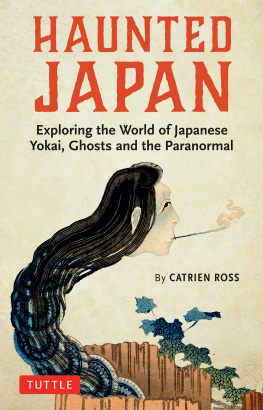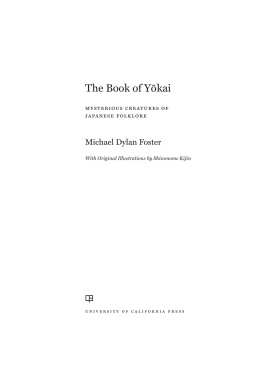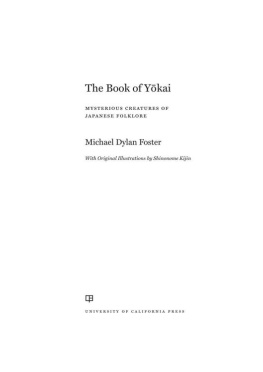HAUNTED
JAPAN

HAUNTED
JAPAN
Exploring the World of Japanese
Yokai, Ghosts and the Paranormal
By CATRIEN ROSS

PHOTOS
Photos are courtesy of the author unless otherwise noted. The photos from the following pages are licensed under the Creative Commons Attribution-ShareAlike 3.0 Unported License: .
COLOR INSERTS
Images are taken from Wikimedia Commons unless otherwise noted. Images not released into public domain by their creators or holding museums, or through expiration of copyright, are licensed under the following Creative Commons licenses: Attribution 2.0 Generic License (Tokyo Imperial Palace); Attribution 3.0 Unported License (Grave of Jesus Christ, Kappa Buchi, Kurama-dera Temple,); Attribution-ShareAlike 3.0 Unported License (The grave of Yaoya Oshichi, Torii on Mt. Haguro); CC0 1.0 Universal Public Domain Dedication (Statues of a Datsue-ba and Kene, The head of Taira no Masakado, Oiwa-Inari Tamiya Shrine, Ichikawa Yonez as the Ghost of Oiwa, Tokaido Yotsuya KaidanOnoe Matsusuke as the Ghost of the Murdered Wife Oiwa, Toriyama Akinari Terutada with Ghost, Kohada Koheiji, Tokaido Gojusan Tsui, Yoshitoshi Ryakuga, Oiwas Ghost).
FOREWORD
J apan is a weird place. I do not mean that in a negative way at all, but in an archaic sense related to the supernatural and the unknown. The roots of Japans mystery and wonder run deep. There are little gods on every street corner. Monsters lurk in every shadow. There is even a town that has a magical rock that was once the dinner table of fierce oni who ravaged the land in ancient times. And theres another with a bridge haunted by a mysterious ghost that appears with a hunk of konyaku stuffed in its mouth so no that one can understand what it is saying. (The oni no maita of Asuka and the konyaku no yurei of Tenri, respectively). And those are just the common obscura. Look further and you will find countless other places such as the mysterious Mt. Osore, whose name translates literally into Mt. Fear, which is examined in this book. All this originates in the creation myth of Japanwhen the god Izanagi-no-mikoto, after returning from his sojourn into the underworld, took a bath to wash away the impurities. As he dried himself his god-water soaked into the soil of Japan, infusing the land with latent supernatural potential.
Since Japan opened to the West in 1853, when American Commodore Matthew C. Perrys ships arrived at Tokyo Bay, there have been those who were, shall we say, attuned to this supernatural potentialthose who embraced it and wrote about it. Percival Lowellhe of the canals on Mars theorywent to Japan in the 1890s. Lowell was amazed by the countrys practice of spirit possession and mediumship and he cataloged them in detail in his 1894 book Occult Japan. Perhaps most famously Lafcadio Hearn went to Japan in 1890, publishing several books on the mysteries he found including Glimpses of Unfamiliar Japan (1894), In Ghostly Japan (1899), and Kwaidan: Stories and Studies of Strange Things (1903). I packed several of these books in my suitcase when I boarded a plane for Japan in 2001, along with a quirky little volume by author Catrien Ross called Supernatural and Mysterious Japannow with the title Haunted Japan: Exploring the World of Japanese Yokai, Ghosts and the Paranormal.
Ross made her own entry to Japan in the late 1980s, just before the crash of the Bubble Era in a time that is now known as Ushinawareta JnenThe Lost Decade. As when Lowell and Hearn arrived, Japan was in a liminal place. And this is where the monsters live. Japan was in a time of transition, moving from what it once was to what it would be. Ross would have encountered a world where businessmen carried blessed amulets in their pockets alongside their portfolio briefings and where faith healers had an equal part of the public discourse as the latest scientific advances. With this book she dove right in.
While the book covers the Edo period and many of Japans classic ghosts, there are other topics that stand out. Most similar studies on Japans supernatural end around the Meiji period. Traditional thinking is that when Japan finally opened to the West after centuries of self-imposed isolation, the countrys love affair with the supernatural sputtered out. But that is right when Ross gets started. Most notably, she covers religions created during the Shinshky (New Religions) movement that followed the lifting of the 260-year religion ban imposed by the Tokugawa Shogunate. Corresponding with the Western Spiritualism movement, this period saw a spurt of revelations and annunciations among people declaring themselves prophets of new gods. Religions such as Omoto and Tenrikyo were founded. Most of these new religions faded into instant obscurity but a few spread out across the world and remain vital institutions today. I appreciated this chapter in particular, as I lived in Nara near Tenri, the Bethlehem for the Tenrikyo religion. No one was able to tell me exactly what was really going on with all the strangely garbed people I occasionally saw wandering the streets other than they were Tenrikyo practitioners. For me, it was the books examination of Omoto and the roots of these religious movements that put the significance of these unique groups into perspective.
I also appreciate the examination of modern topics in Haunted Japan. This book is a plunge into the present as much as into the past. It is to her credit that Ross was curious enough about the country in which she lived to explore not only its past but also the world around her. As a fellow writer on strange Japan I know what a brave move that is. There is a certain professional safety that is afforded when examining ancient supernatural topics in Japan. Write about the yokai encyclopedias of Toriyama Sekien or the phantom visions of artist Maruyama Okyo and no one bats an eyeyou are not judged for discussing these age-old topics. However, write about something more modern and you invite skepticism. This is curious given the fact that the supernatural remains a vital part of Japans cultural landscape. One need look no further than the immensely popular Marie Kondos animistic approach to decluttering that has exploded in popularity in the West. The magic continues to thrive.
Ross chose topics with remarkable prescience. In her exploration of nensha spirit photography she discusses the psychic Sadako Takahashi, whose name would become world famous as the inspiration behind the movie monster Sadako Yamamura from the book and film series Ring. The investigation into Sadako Takahashis powers is a foundation of the original Koji Suzuki Ring novel. Also, in the chapter New Forays into the Mystic, Ross discusses practitioners of the art of geomancy known as fusui, which involves identifying the energy sources of buildings and planning accordingly to maximize their potential. This is a practice with which I am well familiar; the desk I am writing upon on has a heavy chain to help ground my career, and our bed is positioned in our room to tap into our homes latent power. Most modern readers will be equally knowledgeable about fusui, although perhaps they know it better by the Chinese name feng shui. But it was this book where I heard about it first.
Haunted Japan would make a good guidebook for legend trippers looking to discover supernatural surprises off the beaten track. Her section
Next page














